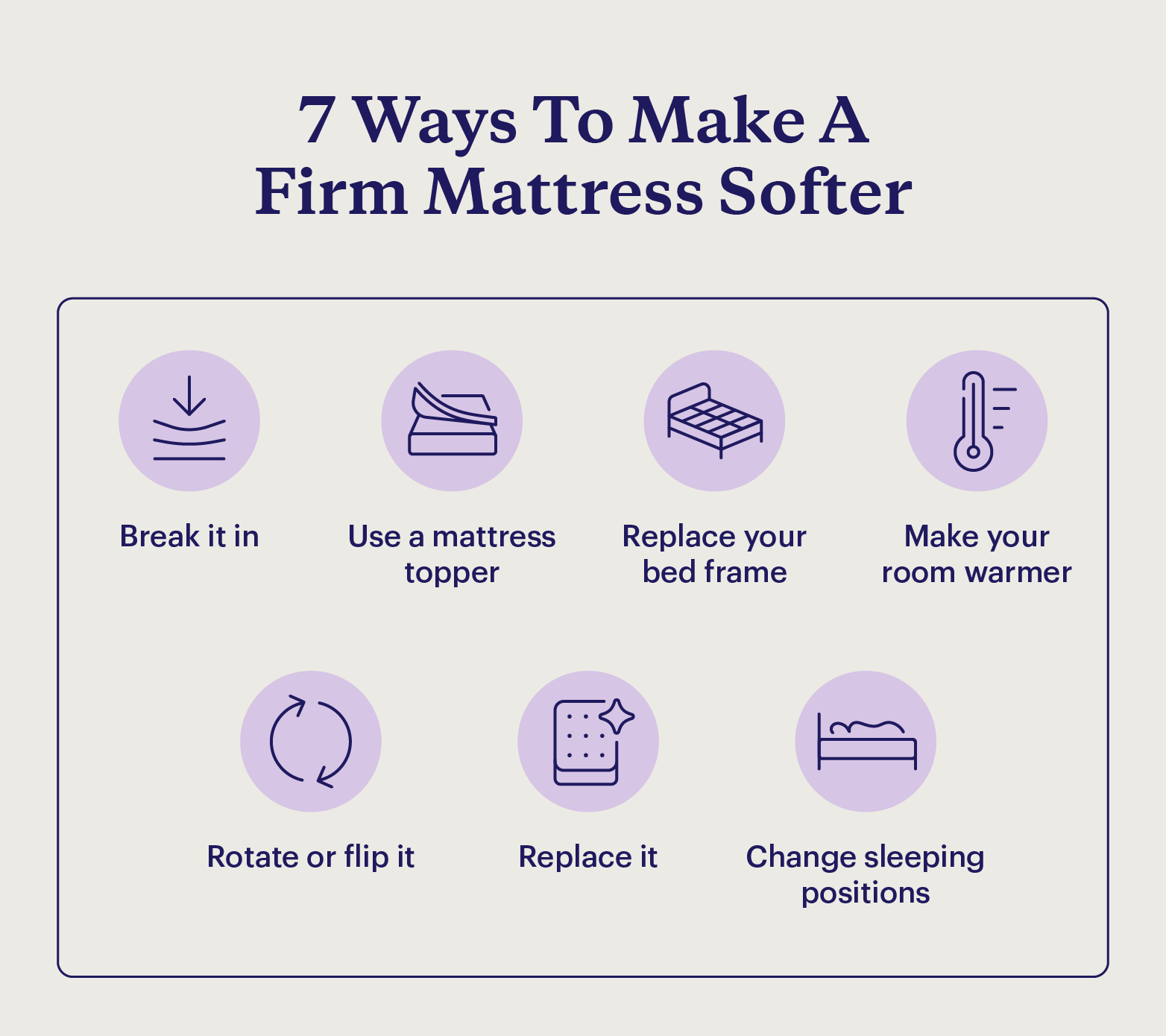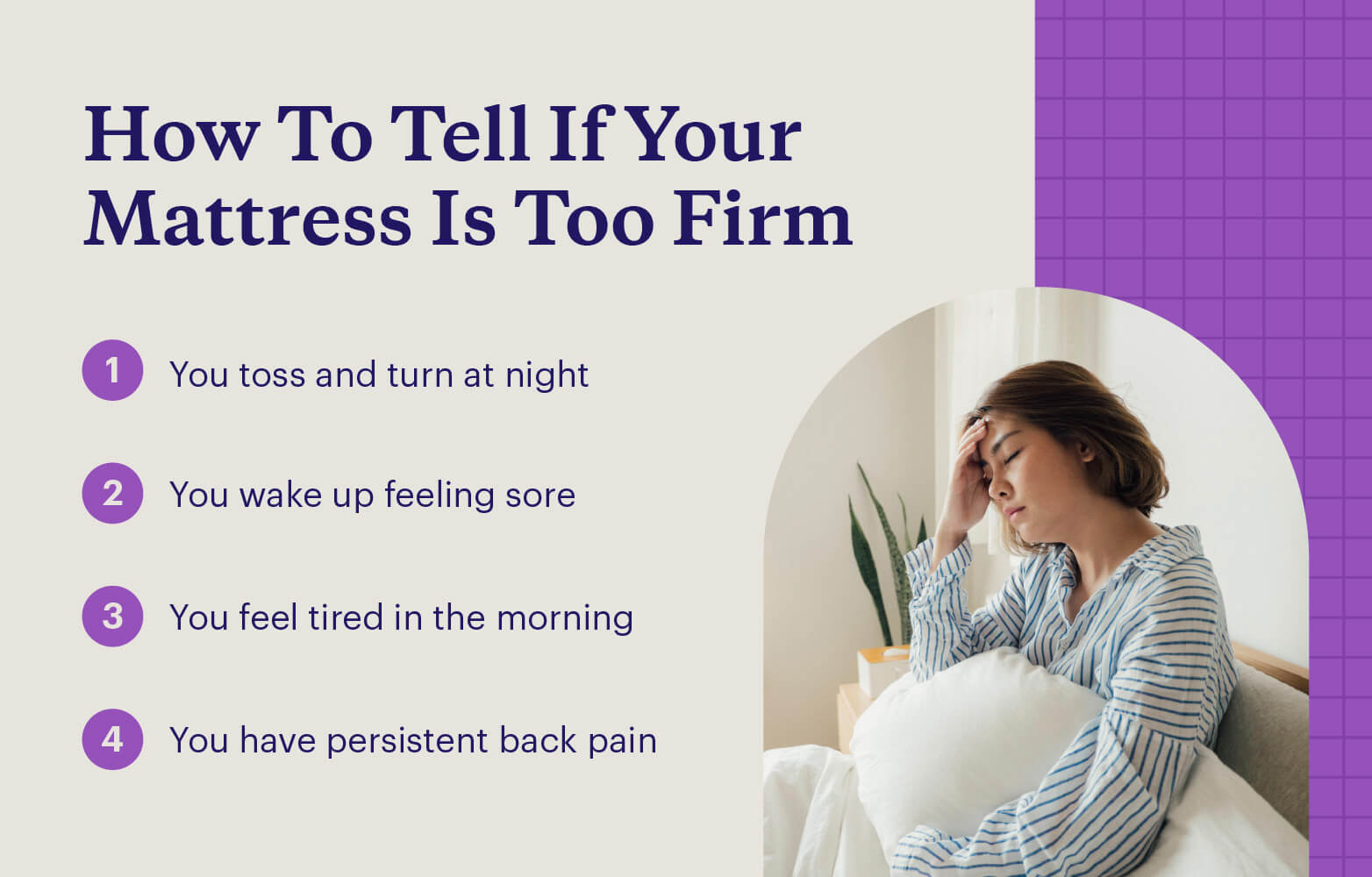
How to Make a Firm Mattress Softer (7 Easy Methods)
Sleepless nights and full-body tension that lasts through the day — all due to an overly firm mattress. You’ve tried to make it work, but the aches, pains, and lack of conforming comfort have become impossible to ignore. So what else can you do?
Whether a return is impossible or a sleep trial wasn’t provided — both of which Purple offers to ensure this situation never arises — you’re in search of a way to make a firm mattress feel softer.
A mattress may feel too firm due to newness, materials, or something else entirely. Regardless of the reason, a mattress that feels too firm is not conducive to deep, restorative rest. If you’ve thought you need a soft, not firm, mattress but you’re not ready to get rid of your current mattress, follow these tips to
- Break in Your Mattress
- Use a Mattress Topper
- Replace Your Bed Frame and Slats
- Make Your Room Warmer
- Rotate or Flip Your Mattress
- Replace Your Mattress
- Change Sleeping Positions
1. Break in Your Mattress
New mattresses tend to feel overly firm since a mattress’ comfort layers adjust to our body contours over time. Repeatedly sleeping on your new mattress allows the various layers to distribute evenly and mold themselves around your body.
To expedite this process, try walking on top of your mattress. While it may take a marathon’s worth of walking to equate to a month’s worth of sleep, the additional concentrated weight may help the break-in process move along quicker.
Many manufacturers offer a trial period of up to one year. This allows time for the mattress to gradually soften. If you’re struggling to reach ideal softness after a reasonable period of time, there are plenty of other methods that will help get you there.
2. Use a Mattress Topper
For mattresses that don't need breaking in, such as older and latex mattresses, try a mattress topper. They're easy to use and provide additional support and cushioning as you sleep. Toppers are usually made of organic and synthetic materials and can be as thick as 2 to 4 inches.
A mattress topper with a lower firmness level may achieve the plush comfort your body is craving
For Purple mattresses, we don’t recommend using a topper. Our mattresses are designed with a proprietary hyper-elastic polymer that flexes under concentrated weight in areas like the hips and shoulders, yet maintains support beneath broad surfaces like the legs and back. Because of our GelFlex® Grid, you don’t have to choose between softness and support.
When your mattress isn’t the problem, it’s time to consider bed frames and slats.
3. Replace Your Bed Frame and Slats
Your mattress’ foundation may be the culprit of excessive firmness. In some cases, solid slats or fixed-slatted bed frames make your mattress feel firmer since they add pressure while supporting your mattress.
Consider opting for a bed frame with sprung slats for a softer-feeling mattress. Sprung slats can:
Reduce strain on your mattress.
- Respond to body pressure and movement.
- Provide cushioned support and can prolong the lifespan of your mattress.
Remember that your choice of bed foundation needs to support the weight of your mattress along with all sleepers, including partners, children, and pets.
Aside from bed frames, firmness related to newness, and mattress toppers, another factor may be at play. Depending on your mattress' materials, the temperature of your room could negatively impact the comfort of your bed.
4. Make Your Room Warmer
Some mattresses are made of temperature-sensitive materials, such as memory foam. If you have a memory foam mattress, try increasing your room’s temperature. Because memory foam conforms with the onset of warmth, such as your body, a warmer room may expedite the process.
A colder room temperature is typically more conducive to deep sleep. If you don’t want to change your room’s temperature, a hot water bottle serves as an alternate means to the same end. Place the bottle beneath your blanket or duvet before getting into bed. This allows time for your mattress to be exposed to heat and, therefore, more pliable when you lay down. If you implement this tip, you may want to cover your mattress with a protector first.
Depending on your needs, a warm room may not be the best temperature for sleep. Our next method is easy to do and can extend the life of your mattress.
5. Rotate Or Flip Your Mattress
Overused mattresses can start to feel uncomfortable when they get worn out. You can flip or rotate a mattress to distribute wear and tear more evenly and improve its lifespan. This can help prevent:
- Indentations
- Lumps
- Sagging
Double-sided mattresses can be flipped over, but many mattresses have a designated top side. Mattresses with one sleeping side should get rotated 180 degrees but not flipped. Check your mattress’ label for instructions on how often it should be flipped or rotated.
Purple mattresses do not need to be flipped or rotated. Our GelFlex® Grid technology is ultra-responsive and long-lasting, with a perfect balance of comfort and support, which is why every Purple mattress comes with a 10-year warranty.
6. Replace Your Mattress
While some mattresses may benefit from the simple solutions listed in this blog, other mattresses may not. Consider replacing your mattress when you’ve exhausted all options and still face excessive firmness.
When choosing a new mattress, you’ll want to consider:
- Mattress size
- Material type
- Firmness level
- Your budget
Purple’s 100-night sleep trial allows you to ensure your ideal firmness before committing to a mattress for 10 years.
7. Change Sleeping Positions
Your mattress may not be the only factor limiting the quality of your sleep. We all prefer different positions for sleeping, but each comes with its own unique set of pros and cons.
For example, back sleepers may prefer a very firm mattress since their flat position typically doesn’t require a great deal of give to ensure proper alignment.
On the other hand, side sleepers may find very firm mattresses uncomfortable because they need a sleeping surface that conforms to their bodies. If you can’t sleep comfortably on your side, try placing a flat pillow between your knees for support.
A mattress suited to your unique sleep habits is the key to achieving a good night’s sleep. Purple’s dynamic assortment of mattresses provides varying feels for every body. Whatever your sleep habits and hurdles, get your best night’s sleep on the GelFlex® Grid.
4 Signs Your Mattress Is Too Firm
If you’re having trouble sleeping, you may wonder if your mattress is too firm or if it’s something else — like your sleeping position. Thankfully, four common signs may indicate whether a mattress is too firm. Before adjusting your bed and mattress, check for these signs:
1. You Toss and Turn at Night
If you’re constantly shifting in bed to find a comfier sleep position, this may be a sign that your mattress isn’t achieving proper spinal alignment or alleviating body pressure.
For people who toss and turn due to anxiety, a weighted blanket can provide relaxation and help your body release serotonin. This can be a natural and effective way to improve your sleep.
2. You Wake Up With Sore, Aching Muscles
A mattress that’s too firm won’t relieve your body’s pressure points, such as your hips, shoulders, and neck. If you feel pain or discomfort in those areas, you may need a softer mattress to cradle your bod.
Make sure you’re in the best sleeping position for your body. Side and stomach sleepers can use pillows to support their knees, neck, and other areas.
3. You Feel Fatigued in the Morning
With unrelieved pressure and restless nights, it’s no wonder that sleeping on a mattress that’s too firm can make you feel exhausted first thing in the morning. This reduces your focus, increases irritability, and decreases your stamina for daily tasks.
Keep in mind that underlying sleep disorders may cause daytime fatigue. These disorders include:
- Obstructive sleep apnea
- Depression
- Allergies
For allergies, consider cleaning and deodorizing your mattress to remove allergens. If changing or cleaning your mattress doesn’t help your daytime fatigue, consult a doctor.
4. You Have Persistent Back Pain
Numerous factors, such as arthritis, bad posture, or the wrong mattress, can cause back pain. An overly firm mattress can add to your back pain instead of relieving it.
While chronic back problems should be checked by a medical professional, you may find it helpful to determine if your mattress is a contributing factor. A mattress that sinks too much under your body, like memory foam, can hurt your back, and a mattress that doesn't cushion your joints may cause stiffness. If you awaken from a nap or a full night of sleep with back pain, the mattress is often a major portion of the issue.
FAQ
While you might be ready for a mattress change, it’s important to consider your options and make an informed decision. For that reason, we’ve answered a series of frequently asked questions about firm mattresses.
Who Should Use A Soft Mattress?
The ideal mattress firmness depends on your sleeping position and body frame. Mattress firmness is ranked on a scale of 1 to 10, with 1 being the softest and 10 being the firmest.
Side sleepers sleep most comfortably on soft (3) to medium-firm (6) mattresses, depending on their body weight. Lightweight sleepers who weigh 130 pounds or less can sleep well on mattresses with a softness of 3 or lower.
Whatever your body size or sleeping position, mattress firmness directly affects your sleep and well-being. If your mattress is too soft or too firm, you may need to change your bed or replace your mattress entirely.
Why Is My New Mattress So Hard?
New mattresses can feel excessively hard because their materials need time to mold to your body. This is why mattress suppliers commonly offer a trial period. Over time, sleeping on your new mattress helps it adjust to your weight and sleeping position.
Your new mattress might also be feeling too hard for comfortable sleep if it’s made from memory foam and your room is cold. The colder your room, the more firm your memory foam will be. Thankfully, the mattress will naturally soften as you sleep due to body heat. Try adjusting the room temperature to expedite this process.
Do Firm Mattresses Get Softer?
All firm mattresses get softer as they adjust to your body weight. Over time, the layers of fabric will mold to your shape, and the mattress will soften.
Firm mattresses will soften before they reach a consistent level of firmness. This usually takes a few weeks of use, which is why companies offer trial periods. Expect any new mattress to get a bit softer, but not by much.
Choose the Right Mattress for a Good Night’s Sleep
Getting quality sleep is key to good physical and mental health. With deep sleep comes all-day alertness and stamina. If your mattress is too firm and none of the above solutions are helping, consider finding a new mattress.



